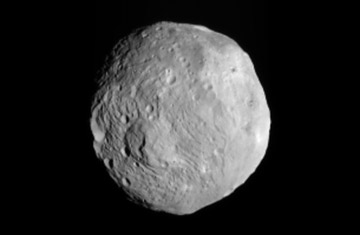
NASA's Dawn spacecraft obtained this image of Vesta on July 9, 2011
There's usually a lot of hoopla when a NASA spacecraft reaches a previously unexplored planet or moon — and deservedly so. Nothing gets the discovery juices flowing like a first glimpse of a whole new world. Still, if you missed the news that the spacecraft Dawn entered orbit around the asteroid Vesta on July 16, you could be forgiven. You don't even have to apologize if you'd never heard of the place; most folks haven't.
The fact is, Vesta is the second largest object in our solar system's asteroid belt — and one of the oldest objects in the solar system as a whole — and Dawn is one of the coolest little spacecraft that NASA has ever built. Together they could yield important clues to the origins of the sun and the planets, not to mention helping NASA engineers demonstrate their increasingly sophisticated cosmic-flying skills.
Vesta was discovered in 1807 and immediately intrigued astronomers. About 360 miles (578 km) across — or roughly the size of Arizona — it is nearly spherical, with a large crater gouged out of its south pole. More-powerful telescopes have shown that the surface of Vesta is covered with basalt, or hardened lava, suggesting that the asteroid was once geologically active. The crater is presumed to be the result of a collision with a chunk of cosmic debris not long after Vesta's formation 4.5 billion years ago. The giant whack cost the asteroid about 1% of its mass, and the rubble blasted into space may account for up to 5% of the meteorites that have reached Earth's surface. Much more important, the crater provides a peek deep into Vesta's interior, which is the same as peeking at the asteroid's — and the solar system's — past.
All that made Vesta eminently worth visiting, but the job of getting there would not be easy. Dawn, launched in 2007, went first into solar orbit, then began a widening spiral that took it by Mars, where it picked up a gravity boost, and finally to Vesta, where it eased into orbit on Sunday.
Vesta's tiny size (on a cosmic scale, at least) means that it has an equally tiny gravitational pull — about 2% that of Earth's. Settling into orbit thus did not require Dawn to execute a long and powerful burn of a traditional chemical engine. Instead, the ship uses far more subtle ion propulsion, a system in which xenon ions are electrically accelerated, creating an exhaust 10 times faster than what a conventional engine produces. The hitch is, the ion stream is so thin that the overall thrust it produces is only about 91 millinewtons. How weak is that? Pick up a piece of paper and try to feel the gravity pulling it downward; that's 91 millinewtons. Still, since the ion engines are burned and steered almost continuously throughout the mission, the thrust accumulates, ultimately exceeding that of the Delta booster that got Dawn off the pad in the first place.
During the year the spacecraft will spend orbiting Vesta, it will study the asteroid with a cluster of instruments including two visual cameras equipped with seven color filters, a visible and infrared mapping spectrometer that will reveal the makeup of the surface of Vesta and a gamma ray and neutron detector that will conduct similar analyses to a depth of 3 ft. (1 m).
When its time at Vesta is over, Dawn will fire up its ion engines, puff its way out of orbit and point its prow toward Ceres, a spherical asteroid that is the largest in the solar system — 606 miles (909 km) across, or about the size of Texas. Ceres is thought to have a layered interior like Earth's and may be up to 25% water — a suspicion the subsurface gamma ray and neutron detector may at last confirm. Dawn will arrive at Ceres in February 2015 and study the little world for five months, finally ending its mission that July.
The pictures and data that Dawn returns may never dazzle the public the way the Hubble Telescope's great portraits of the cosmos have. We'll have to settle instead for learning a lot more than we ever knew about the origins of our solar system — and thus of ourselves. Not a bad eight-year mission for a spaceship that many people never even knew existed.
